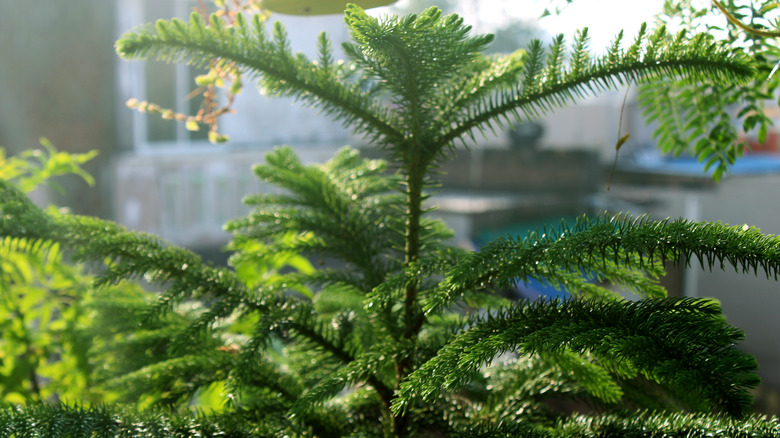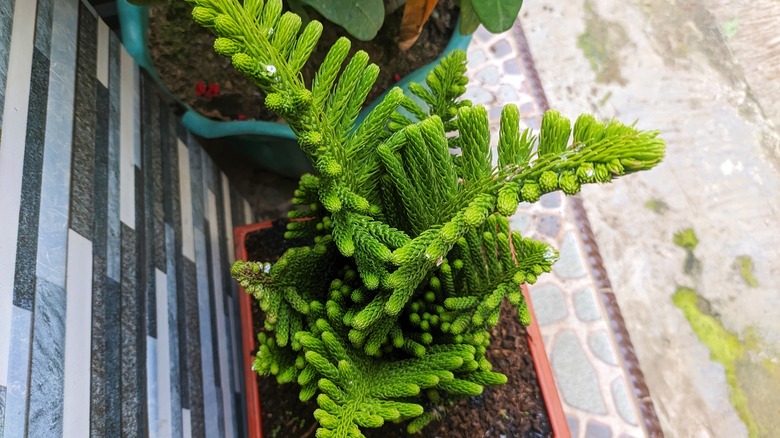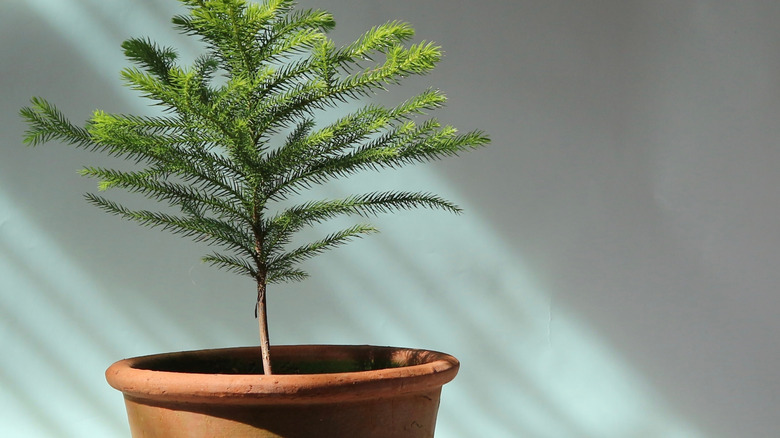Want To Keep Your Norfolk Pines Safe This Winter? Martha Stewart Has You Covered
Despite their Christmas tree-like appearance, Norfolk Island pines (Araucaria heterophylla) are actually a tropical plant. These conifers are native to Norfolk Island, a small land mass east of Australia and north of New Zealand. While they're mostly kept as houseplants in North America, they can survive outside in USDA Hardiness Zones 10 and 11 even through the winter. You can also keep these beauties outside in pots during the summer in other regions as well. However, you will need to take measures to keep them safe during the winter. According to Martha Stewart, you should carefully repot and bring your Norfolk pines inside before temperatures drop too much outside.
"Caring for my precious potted plants means following a strict schedule, particularly at the end of the warm season," Stewart shares in her blog, Martha Up Close and Personal. Norfolk pines thrive in temperatures between 65 to 85 degrees Fahrenheit. Once temperatures start to dip below 60 degrees Fahrenheit, you'll need to prepare to bring them inside; Stewart says her Norfolk pines cannot survive in temperatures under 50 degrees. Armed with fresh potting soil and plastic pots, you can start getting your own Norfolk pines prepped to overwinter indoors with Stewart's technique. You'll be able to keep them safe all winter while adding life to your home with indoor trees.
How to overwinter your Norfolk pine, according to Martha
"Before the plants are stored, they're repotted in plastic containers," Stewart explains in her blog. This allows you to keep your decorative pots outside instead of having to lug them inside. She fills each plastic container about one-third of the way full with fresh potting mix. Then, to give the Norfolk pines a leg up over the winter, Stewart's gardeners use a sharp knife to slice off the very bottom layer of the root ball. Not only does this help the plant fit in its overwintering pot better, but it also stimulates new growth. From there, you can place the plants in the pots, top off with soil, and add smart-release fertilizer. Now your plants are ready to move inside.
Your plants should be nice and cozy until it comes time to bring them outside again. Not only is this a foolproof way to ensure your plants survive, but keeping your Norfolk pines inside also offers aesthetic benefits, wowing with their fluffy, needle-like foliage and symmetrical shape. A Norfolk pine can also serve as the perfect Christmas tree alternative for a small space. Protecting your Norfolk pine during the winter will keep it healthy for years to come and give you the opportunity to enjoy its beauty year-round.
Cultivating an indoor paradise for your Norfolk Pine
The work isn't over once you bring your Norfolk Island pine inside. Be sure to treat your new resident to a lavish in-home winter getaway. Stewart keeps her Norfolk Island pines under grow lights — it's her secret to maintaining tropical plants in the winter. But if that isn't an option for you, your plants should be just fine until spring as long as they receive bright, indirect light from a window. They also require moist soil and humidity. To achieve a more humid environment while inside, you can fill a dish with water and rocks, balancing the pot above the waterline. This will encourage a humid microclimate. You can also mist your plant for a temporary humidity boost.
Look out for any signs of distress as your Norfolk pine overwinters. These plants tend to be robust in the proper conditions, but moving them may cause some stress. If you notice any wilting or other signs of decline, your plant might be experiencing transplant shock. This is temporary; allow it time to bounce back before you panic. Pests can also hitch a ride indoors, so check the plant for signs of spider mites or scale throughout the winter. Browning leaves at the bottom are normal, but if you notice them higher up, that might point to underwatering, overwatering, or a lack of humidity. Adjust accordingly and enjoy your winter houseguest — you're free to place it outside again once nighttime temperatures are consistently above 50 degrees Fahrenheit.


